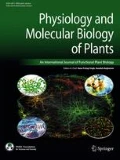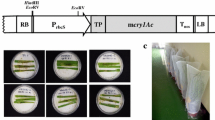Abstract
Agrobacterium-mediated co-transformation method was used to generate marker-free insect resistant transgenic okra plants expressing the cry1Ac gene. The cry1Ac gene was borne on the T-DNA of one plasmid while nptII and uidA (GUS) marker genes were present on the T-DNA of a second plasmid. Putative transgenic plants were screened by histochemical GUS assay for expression of -glucuronidase and 32 transgenic events were positive for GUS in which 21 transgenic events were positive in ELISA for the presence of Cry1Ac protein. Out of 21 Cry1Ac positive T0 events, three events displayed Mendelian inheritance of the transgenes in (9:3:3:1 ratio) T1 generation for Cry1Ac and GUS. Selected events were chosen for further genetic and molecular analysis. The cry1Ac and marker genes were found to segregate independently, of each other in 10 events in T1 generation out of 11 Cry1Ac gene inheriting events analysed indicating that the two T-DNAs insertions were genetically unlinked and identification of marker-free plants were possible in these 10 events. The marker-free nature and vector backbone-free Bt events (clean T-DNA insertions carrying cry1Ac gene) were confirmed by Southern analysis using suitable probes. The plants from selected transgenic events were rigorously screened in whole plant insect bioassays using the larvae of shoot and fruit borer, Earias vittella, an important pest of okra. Insect bioassays indicated 100% larval mortality without any infestation in five of the transgenic events and two events showed 5 to 10 percent infestation establishing the insect resistant nature of the transgenic plants. Finally the events inheriting transgenes in Mendelian fashion were characterized further and marker-free and vector backbone-free events were identified showing complete protection from the target pest Earias vittella in whole-plant insect bioassays. Quantification of Cry1Ac protein levels in the plant parts of selected events (lines) was consistent with the results of bioassays. Further, two lines identified in this study met the criteria for inclusion in commercial breeding programs.





Similar content being viewed by others
Abbreviations
- Bt :
-
Bacillus thuringiensis
- GUS:
-
-Glucuronidase
- nptII:
-
Neomycin phosphotransferase II
- DAS-ELISA:
-
Double antibody sandwich-enzyme linked immuno sorbent assay
References
Adang MJ, Staver MJ, Rocheleau TA, Leighton J, Barker RF, Thompson DV (1985) Characterized full-length and truncated plasmid clones of the crystal protein of Bacillus thuringiensis subsp. kurstaki HD-73 and their toxicity to Mandula sexta. Gene 36:289–300
Bansode AG, Patil CS, Jadhav SS (2015) Efficacy of insecticides against shoot and fruit borer, Earias vittella F. infesting okra. Pest Manag Hortic Ecosyst 21:106–109
Beck E, Ludwig G, Auerswald EA, Reiss B, Schaller H (1982) Nucleotide sequence and exact localization of the neomycin phosphotransferase gene from transposon Tn5. Gene 19(19):327–336
Choudhary S, Sharma A (2020) Population dynamics of shoot and fruit borer, Earias spp. infesting Okra. J Entomol Zool Stud 8(6):499–501
Daley M, Knauf V, Summerfelt K, Turner J (1998) Co-transformation with one Agrobacterium tumefaciens strain containing two binary plasmids as a method for producing marker-free transgenic plants. Plant Cell Rep 17:489–496
Doyle JJ, Doyle JL (1987) A rapid DNA isolation procedure for small quantities of fresh leaf tissue. Phytochem. Bull. 19:11–15
Halder RAB, J and Kodandaram MH, (2014) Emerging insect pest problems in vegetable crops and their management in India: an appraisal. Pest Manag Hortic Ecosyst 20(2):113–122
Hare PD, Chua N-H (2002) Excision of selectable marker genes from transgenic plants. Nat Biotechnol 20:575–580
Jefferson RA, Burgess SM, Hirsh D (1986) Beta-glucuronidase from Escherichia coli as a gene-fusion marker. PNAS USA 83:8447–8451
Koundinya AVV, Sidhya P, Pandit MK (2014) Impact of Climate Change on Vegetable Cultivation - A Review Journal of Agriculture. Environ Biotechnol 7:145–155
Khalifa AHA, Dhankhar BS, Mishra JP (2009) Quality, nutrition, and culinary uses. In: Okra handbook- global production, processing and crop improvement. HNB Publishing, New York, pp 125–158.
Komari T, Hiei Y, Saito Y, Murai N, Kumashiro T (1996) Vectors carrying two separate T-DNAs for co-transformation of higher plants mediated by Agrobacterium tumefaciens and segregation of transformants free from selection markers. Plant J 10:165–174. https://doi.org/10.1046/j.1365-313X.1996.10010165.x
Manickavasagam M, Kondeti S, Ishwarya R, Elayaraja D, Ganapathi A (2015) Assessment of factors influencing the tissue culture-independent Agrobacterium-mediated in planta genetic transformation of okra [Abelmoschus esculentus (L.) Moench]. Plant Cell Tiss Organ Culture 123(2):309–320
Menon R, Sarao N, Pathak N (2018) In planta Agrobacterium- mediated genetic transformation in okra (Abelmoschus esculentus (L.) moench). Appl Biol Res 20(3):221–228
Murashige T, Skoog F (1962) A revised medium for rapid growth and bioassays with tobacco tissue cultures. Physiol Plant 15:473–497
Narendran M, Lalwani S, Girhepuje P, Shirale D, Mustafa G, Gandhi R, Parimi S, Char BR, Zehr UB (2007) Production of marker-free insect resistant transgenic brinjal (Solanum melongena L.) carrying cry2Ab gene. Acta Hort 752:535–538
Narendran M, Deole SG, Harkude S, Shirale D, Nanote A, Bihani P, Parimi S, Char BR, Zehr UB (2013) Efficient genetic transformation of okra (Abelmoschus esculentus (L.) Moench) and generation of insect-resistant transgenic plants expressing the cry1Ac gene. Plant Cell Rep 32(8):1191–1198. https://doi.org/10.1007/s00299-013-1415-4
Pareek BL, Bhargava MC (2003) Estimation of avoidable losses in vegetable crops caused by borers under semi arid condition of Rajasthan. Insect Environ 9:59–60
Rai AB, Halder J, Kodandaram MH (2014) Emerging insect pest problems in vegetable crops and their management in India: An appraisal. Pest Manag Hortic Ecosyst 20(2):113–122
Sarkar S, Roy S, Ghosh SK (2021) Development of marker-free transgenic pigeon pea (Cajanus cajan) expressing a pod borer insecticidal protein. Sci Rep 11:1–6
Satpute NS, Deshmukh SD, Rao NGV, Tikar SN, Moharil MP, Nimbalkar SA (2003) Native insecticide resistance in spotted bollworm, Earias vittella (Fabricius), in western Vidarbha region of India. Resistant Pest Manag Newsl 13:9–11
Srivastava AK, Trivedi P, Srivastava MK, Lohani M, Srivastava LP (2011) Monitoring of pesticide residues in market basket samples of vegetable from Lucknow City, India. Environ Monit Assess. 176:465–472.
Xu Z, Yu M, Yin Y, Zhu C, Ji W, Zhang C, Li Q, Zhang H, Tang S, Yu H, Liu Q (2020) Generation of selectable marker-free soft transgenic rice with transparent kernels by downregulation of SSSII-2. Crop J 8:53–61
Yau Y-Y and StewartJr CN (2013) Less is more: strategies to remove marker genes from transgenic plants. BMC Biotechnol 13–36. https://doi.org/10.1186/1472-6750-13-36.
Yoder JI, Goldsbrough AP (1994) Transformation systems for generating marker-free transgenic plants. Nat Biotechnol 12:263–267
Zala SP, Patel JR, Patel NC (1999) Impact of weather on magnitude of Earias vitella infesting okra. Indian J. Entomol. 61(4):351–355
Zehr UB, Narendran MN, and Deole SG. Methods for Plant Regeneration, Transformation and Production of Insect Resistant Transgenic Okra. United States Patent no. 8,067,673 issued on 29th November 2011.
Author information
Authors and Affiliations
Contributions
SD Performed okra transformation, segregation and kanamycin sensitivity assay, SP (Sanjeev), MJ and PB planned and carried out the molecular analysis (Southern analysis), AN carried out Cry1Ac protein quantification, SSR and SP (Srinivas) designed, conducted and analysed the results of insect-bioassays. NM planned, co-ordinated the project and prepared the manuscript. UZ and BRC reviewed and revised the manuscript. All authors read and approved the manuscript.
Corresponding author
Additional information
Publisher's Note
Springer Nature remains neutral with regard to jurisdictional claims in published maps and institutional affiliations.
Rights and permissions
About this article
Cite this article
Deole, S., Padakipatil, S., Sandhya, S.R. et al. Development of marker-free insect resistant transgenic okra (Abelmoschus esculentus L. Moench) expressing the cry1Ac gene and identification of vector backbone-free events. Physiol Mol Biol Plants 27, 2379–2387 (2021). https://doi.org/10.1007/s12298-021-01074-3
Received:
Revised:
Accepted:
Published:
Issue Date:
DOI: https://doi.org/10.1007/s12298-021-01074-3




